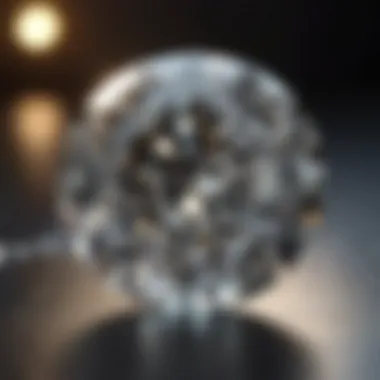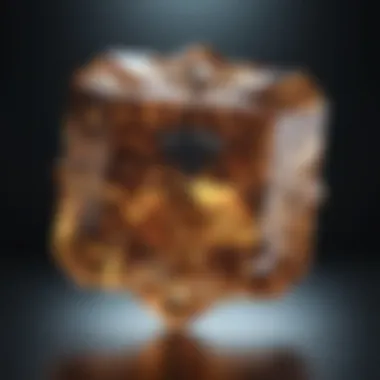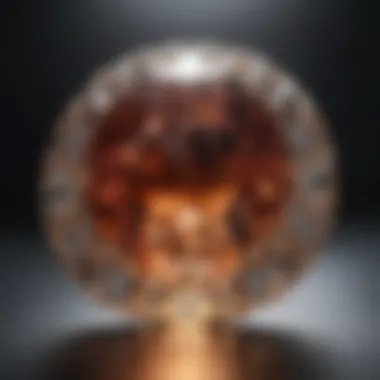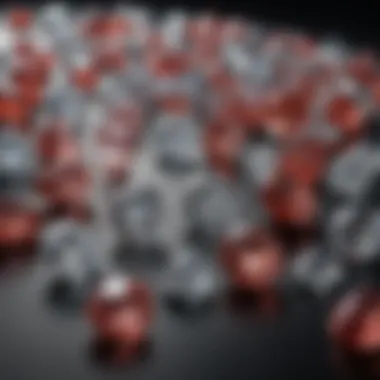Evaluating Diamond Shapes: Finding the Optimal Choice


Intro
When considering the purchase of a diamond, the choice of shape often becomes a foundational element in defining the overall aesthetic of a piece of jewelry. Diamonds come in various forms, each with distinct characteristics that can influence not only appearance but also personal preference. Understanding these shapes can enhance a buyer's ability to select a diamond that aligns with their vision and style.
This article examines different diamond shapes, discussing their unique qualities, advantages, and disadvantages. Insights into design considerations are provided alongside explanations of grading factors such as color, clarity, and cut, all of which significantly affect the visual appeal of the stone. The analysis also addresses cultural significances associated with various shapes, ultimately assisting potential buyers in identifying the diamond shape that best complements their personal preferences.
Gemstone Overview
Definition and Origins
Diamonds are precious gemstones composed of carbon atoms arranged in a crystal structure known as diamond cubic. This unique arrangement grants diamonds their exceptional hardness, making them the hardest known natural material. The origins of diamonds trace back millions of years. They form deep within the Earth's mantle under extreme pressure and temperature conditions, later brought to the surface through volcanic eruptions. Today, diamonds are not only sought after for their brilliance but also appreciated for their unique geological history.
Historical Significance
Historically, diamonds have been revered for their beauty and rarity. In ancient India, diamonds were valued not just for adornment but were believed to possess protective and healing properties. During the Renaissance, European nobility began to wear diamond jewelry as symbols of wealth and power. The late 19th and early 20th centuries saw diamonds becoming associated with romantic engagements and love, further solidifying their cultural importance in modern society. As such, choosing a diamond shape often involves not just aesthetics but also an appreciation for its historical narrative.
Gemstone Properties
Hardness and Durability
Diamonds are known for their unparalleled hardness, rated 10 on the Mohs scale of mineral hardness. This durability ensures that diamonds can withstand daily wear without scratching or damaging. However, it is essential to consider that while diamonds are tough, they can be chipped if struck at the right angle. Choosing a well-crafted setting can mitigate this risk and enhance the longevity of the jewel.
Color and Clarity
When evaluating diamonds, color and clarity are two critical attributes that significantly influence the stone's value and beauty.
- Color: Diamonds range from colorless to shades of yellow, brown, and even rare colors like blue or pink. The more colorless a diamond, the more valuable it is considered. Popular shapes such as round brilliant diamonds tend to face up whiter, emphasizing their brightness.
- Clarity: This refers to the presence of internal or external flaws known as inclusions and blemishes. The clarity scale ranges from Flawless (no inclusions) to Included (inclusions visible to the naked eye). Clarity affects the perceived beauty of the diamond, making it an essential consideration when selecting the shape.
"Choosing the right diamond shape can enhance the light performance and aesthetic characteristics of the stone."
Potential diamond buyers should take time to understand these properties as they contribute significantly to the overall appeal and value of the gem.
As we delve deeper into evaluating specific diamond shapes, each will be analyzed in terms of their unique visual effects, suitability for various settings, and the emotions they evoke in potential wearers.
Preamble to Diamond Shapes
Selecting a diamond involves careful thought about its shape. The choice of shape is not merely a matter of aesthetics; it impacts the overall perception of a diamond's beauty and value. Understanding different diamond shapes allows a buyer to make a well-informed decision, ensuring that the selected stone meets both personal and practical needs.
In this section, we will delve into the essence of diamond shapes. It is crucial to recognize how shapes can influence light performance and how they relate to various styles. By grasping these elements, buyers can appreciate the importance of their choice. Ultimately, the objective remains to connect with a diamond that resonates with individual preferences while fulfilling the technical criteria essential to diamond selection.
Understanding Diamond Shapes
Diamond shapes refer to the geometric outline of a diamond when viewed from above. Each shape has distinct characteristics that can appeal to different tastes. The round brilliant cut, for example, is a popular choice due to its classic look and exceptional light reflection capabilities. On the other hand, shapes like the princess cut offer a modern twist with a unique, angular design.
The fundamental shapes vary, but they are often categorized into two main types: brilliant and fancy shapes. Brilliant cuts are designed to maximize brilliance and sparkle. They include shapes like the round and oval. Fancy shapes, which encompass the remaining styles, provide more diversity and personality.
Being familiar with these shapes enables buyers to weigh their options based on how they complement individual styles. The shape can also affect the settings and designs available, making it a cornerstone consideration while purchasing.
Importance of Shape in Diamond Selection
The shape of a diamond influences more than just aesthetics; it plays a pivotal role in determining value. Different shapes can possess varying levels of demand in the market, affecting resale value. Moreover, the right shape can emphasize the qualities of a diamond, like clarity and color, which are crucial grading factors.
Choosing a shape also reflects personal style and lifestyle. It potentially conveys messages when used in jewelry, such as engagement rings or other personal ornaments. For instance, a round cut may symbolize tradition, while an emerald cut can reflect a contemporary minimalist line.
When selecting a diamond, the following considerations come into play:


- Market Trends: Analyze which shapes are currently in demand.
- Resale Value: Investigate how the shape impacts potential future sales.
- Personal Expression: Choose a shape that resonates with personal style.
Ultimately, the shape of a diamond signifies both personal and cultural significance. It connects the buyer to a deeper understanding of diamond aesthetics, value, and symbolism.
Detailed Analysis of Shape Options
Analyzing various diamond shapes is pivotal for anyone seeking to acquire a diamond. Each shape has its own characteristics that influence its appearance and the overall impression it conveys. This detailed analysis allows potential buyers to understand not only the aesthetic qualities of each cut but also the practical considerations regarding their choices.
- Beauty and Individualization: The way a diamond is cut significantly impacts its visual appeal. Each shape reflects light differently, which can enhance or diminish its sparkle. Personal style should align with the selected shape to ensure satisfaction.
- Market Trends: Different diamond shapes fluctuate in popularity. Understanding these trends can assist buyers to choose a timeless piece or a contemporary style that suits their needs.
- Resale Value: The shape of a diamond can also influence its resale value. Specific shapes may be more sought after in the market, making this analysis crucial for investment purposes.
- Setting Compatibility: Some shapes fit better with certain jewelry settings. For instance, a round brilliant cut suits various engagement rings, while an emerald cut often features in classic settings.
By delving into each shape's benefits and unique attributes, buyers can make informed decisions that resonate with their preferences and needs.
Round Brilliant Cut
The Round Brilliant Cut is by far the most popular diamond shape. Renowned for its ability to reflect light, this cut features 58 facets, ensuring exceptional brilliance and sparkle. The symmetrical design maximizes the light interactions, giving a captivating display.
Benefits:
- Brightness: Its design allows for immense light return.
- Versatility: Suitable for various settings, enhancing any style.
- Market Appeal: High demand often correlates with good resale value.
Princess Cut
The Princess Cut has emerged as a favorite among modern purchasers. It combines a contemporary appeal with sharp corners and a square or rectangular shape. The many facets contribute to its shine and fire, making it exceptionally vibrant.
Benefits:
- Unique Style: A fresh alternative to traditional cuts.
- Optimal Use of Diamond Weight: Engages larger stones in rings without loss of size.
- Design Flexibility: Complements various styles from modern to classic.
Oval Cut
The Oval Cut presents an elongated shape, offering a distinctive aspect to its wearer. It possesses the same brilliance as the round cut but provides an illusion of greater size. This makes it a favored choice for those desiring larger stones without the higher cost.
Benefits:
- Appearance of Size: The shape makes it look larger than its carat weight.
- Flattering Shape: Its elongated form can enhance the appearance of fingers.
- Custom Settings: Works well with various ring designs.
Emerald Cut
The Emerald Cut is numbered among the elegant shapes, characterized by its step-cut facets. It focuses more on clarity than on sparkle, providing a sophisticated and vintage look. This style can highlight inclusions, making flawless stones more desirable for this cut.
Benefits:
- Sophisticated Look: Offers a glamorous vintage appeal.
- Focus on Clarity: Emphasizes the diamond's clarity, making quality paramount.
- Unique Light Play: Reflects a hall-of-mirrors effect that is captivating.
Marquise Cut
The Marquise Cut resembles a boat shape with points on both ends. This unique cut has a longer silhouette which many find appealing. Its shape maximizes carat weight, resulting in a visually larger diamond.
Benefits:
- Lengthening Effect: Offers an elegant look, enhancing finger length.
- Shape Flexibility: Fits well in many styles and settings.
- Impressive Carat Value: Often larger in appearance without additional costs.
Pear Cut
The Pear Cut combines elements of both the oval and marquise shapes. It features a rounded end and a pointed end, providing a teardrop appearance. This shape is favored for its unique aesthetic and charm.


Benefits:
- Stylish Alternative: Offers a distinctive look.
- Versatile Settings: Adaptable to various band types and configurations.
- Dynamic Sparkle: The cut ensures light variations for captivating effects.
Asscher Cut
Much like the emerald cut, the Asscher Cut is recognized for its emerald-cut characteristics but with a square shape. It possesses larger step facets that enhance clarity and depth.
Benefits:
- Art Deco Revival: Reflects vintage glamour appealing to collectors.
- Depth and Clarity: Allows visibility of the diamond's inner qualities.
- Matching Inspiration: Works well with both modern and traditional designs.
Cushion Cut
The Cushion Cut is often described as a hybrid of round and square shapes, featuring rounded corners and larger facets. Known for its vintage charm, it has gained modern popularity.
Benefits:
- Romantic Look: The cut provides warmth and a softer appearance.
- Variation in Sizes: Available in many proportions to suit different aesthetics.
- Light Interaction: Creates a captivating glow and sparkle.
Understanding these diamond shapes and their unique characteristics is essential for a knowledgeable selection. This analysis allows buyers to consider not just aesthetics but also practical aspects relevant to personal taste and potential future resale.
Factors Influencing Diamond Shape Selection
Choosing the right diamond shape is not just about aesthetics; it encompasses multiple factors that reflect the buyer's individual preferences and the purpose of the diamond. When selecting the ideal diamond shape, understanding these influences is crucial for making a thoughtful and informed choice. Some key elements to consider include personal taste, the intended use of the diamond, and lifestyle compatibility. Each of these aspects can significantly affect the overall experience and satisfaction with the diamond.
Personal Style and Aesthetic Preferences
Every person has unique tastes. Specific diamond shapes can resonate deeply with individual styles. For instance, someone who prefers classic elegance may lean towards a Round Brilliant Cut, known for its timeless appeal and exceptional sparkle. Others might favor the modern lines of a Princess Cut or the vintage charm of an Asscher Cut.
When deciding on a shape, it is helpful to consider how the diamond will complement existing jewelry. Here are some aspects to ponder:
- Body Structure: Certain shapes can emphasize different features. For example, elongated shapes like the Oval Cut can enhance slender fingers.
- Color: Some shapes may highlight the diamond's clarity, while others can play with color more, offering different visual effects.
- Context: Consider where the diamond will be worn most, whether it’s for everyday use or special occasions.
Ultimately, aligning the diamond shape with personal style ensures that the wearer feels confident and satisfied.
Purpose of the Diamond: Jewelry vs. Investment
Understanding the purpose behind acquiring a diamond is another vital component in shape selection. For some, purchasing a diamond might present a means of expressing sentiment, commonly seen in engagement rings or anniversary gifts. For those individuals, emotional meaning usually takes precedence over long-term value. On the other hand, people buying diamonds as an investment will prioritize factors like resale value and market demand. Some diamond shapes retain their worth better than others, including the classic Round Brilliant Cut, celebrated for its popularity and consistent demand.
When considering purpose:
- Jewelry: Emotional significance may lead to choosing a shape that resonates personally and symbolically rather than one that enhances potential investment returns.
- Investment: For interested investors, shapes with historically high resale values often include Round and Princess Cuts, as they tend to attract more buyers.
Lifestyle Considerations
Finally, choosing a diamond shape should not ignore lifestyle. Someone leading an active life might prefer a more durable shape that withstands everyday wear. For instance, the Round Brilliant Cut or Cushion Cut can provide a balance of beauty and robustness.
It is wise to think about:
- Daily Wear: A simpler style might be practical for someone whose job or lifestyle involves constant movement.
- Maintenance: Certain shapes and settings may require more care, such as the Emerald Cut, which can be more prone to visible inclusions.
Ensuring that the diamond fits seamlessly into daily life enhances not only the joy of ownership but also the long-term satisfaction of the purchase.
Selecting a diamond shape is a personal decision influenced by individual style, purpose, and lifestyle. Understanding these factors leads to a more fulfilling choice.


The Role of Diamond Grading
Diamond grading plays a critical role in understanding the value and quality of a diamond. It serves not only as a method for determining worth but also as a guideline for making informed purchases. This section delineates the aspects of diamond grading that are essential for discerning buyers.
The 4Cs of Diamonds—cut, color, clarity, and carat weight—form the foundation of diamond grading. Each of these characteristics significantly influences not only the overall appearance but also the value. Understanding these elements allows buyers to assess which diamond shapes might suit their particular needs and aesthetics.
In addition, the grading process provides an objective measure that compares different diamonds against standardized criteria. This objective yardstick assists collectors, enthusiasts, and designers to gauge qualities without succumbing to subjective opinions or marketing ploys. Ultimately, grading enhances transparency in the diamond market and supports confident decision-making.
"Grading is essential not just for evaluating diamonds but for understanding their unique qualities that contribute to their beauty and value."
Understanding the 4Cs of Diamonds
The 4Cs of Diamonds is a universally accepted standard that describes the four key characteristics of diamonds: cut, color, clarity, and carat weight. Here’s a brief overview of each:
- Cut: This refers to how well the diamond has been shaped and faceted. A well-cut diamond reflects light beautifully, enhancing its brilliance.
- Color: Diamonds come in a range of colors, although the most sought-after are typically colorless. The grading scale varies from D (colorless) to Z (light yellow or brown).
- Clarity: This indicates the presence of inclusions or blemishes within the diamond. Clarity grades range from Flawless to Included, with many options in between.
- Carat Weight: This measures the physical weight of the diamond. One carat equals 200 milligrams. Generally, larger diamonds carry a higher weight, but this doesn't directly translate to better quality.
Understanding the 4Cs enhances the buyer's knowledge and helps to navigate the diverse market. Showing particular attention to these factors can lead to more satisfying and valuable selections.
Cut Quality and Its Impact on Shape
Cut quality disproportionately affects a diamond's visual appeal and is often considered the most crucial of the 4Cs. The cut not only determines the diamond’s brilliance but also how it interacts with light. A well-executed cut can enhance the shape, making it appear more vibrant and lively.
- Impact on Shape: Different shapes require different cutting techniques. A round or princess-cut diamond benefits immensely from a precise cut, maximizing its sparkle. On the other hand, cuts like emerald or oval might require specific angles and proportions to showcase their unique features.
- Individual Preferences: Buyers often gravitate towards certain shapes based on personal taste, but cut quality should not be overlooked. For instance, even if a buyer chooses a popular shape, inadequate cut quality can result in a dull stone, regardless of its form.
Cultural and Historical Context
The cultural and historical context of diamond shapes offers significant insights into how these gems are perceived and valued across different societies. Diamonds are not only ornaments but bear deep-rooted meanings that evolve through time and culture. Understanding these elements can assist buyers in selecting a diamond shape that resonates with their identity or values, making it not just a purchase but a statement of personal or cultural significance.
Symbolism of Different Diamond Shapes
Each diamond shape carries unique symbolism that can influence buyer preference. For example, the round brilliant cut stands as a symbol of brilliance and eternal love, often associated with engagements and weddings. Its shape maximizes fire and light, making it a popular choice in Western cultures. In contrast, the oval cut signifies elegance and uniqueness, appealing to those who desire a diamond that is slightly different yet equally stunning. The pear cut, with its teardrop-like form, embodies the concept of tears of joy, prominent in celebratory contexts such as anniversaries.
Overall, the emerald cut is often linked with sophistication and class. Its 'step' facet structure exudes a vintage appeal, harkening back to old Hollywood glamour. Similarly, the princess cut, symbolizing modernity, resonates with younger generations seeking contemporary design. Buyers should consider these meanings when selecting a diamond shape, as they can reflect personal milestones or values with deeper connection.
Cultural Preferences for Shapes
Cultural preferences for diamond shapes can vary significantly, impacting consumer choices around the globe. In many Western cultures, the round brilliant and princess cuts are favored for engagement rings due to their romantic connotations. In contrast, in Asian cultures, the cushion cut holds popularity for its vintage aesthetic and perceived emotional value. This might stem from traditional beliefs about shapes and their effects on fate or fortune.
Moreover, certain diamond shapes may also become fashionable in specific regions based on celebrity endorsements or market trends. For instance, the resurgence of the marquise cut has been notably observed in contemporary jewelry, illustrating how cultural icons can revitalize interest in particular styles.
"The shape of a diamond may speak volumes about the wearer’s style and taste, but it also serves as a reflection of cultural heritage and personal background."
Ultimately, understanding these cultural and historical contexts allows buyers not only to select a diamond that reflects their aesthetic preferences but also to choose one that resonates with their cultural identity and personal experiences. The thoughtful engagement with diamond shapes enhances the purchase, transforming it into a meaningful artifact rather than a mere accessory.
Closure: Determining the Best Shape
Selecting a diamond shape represents a significant decision in jewelry purchasing. Choosing the optimal shape can influence the overall aesthetic of the piece and how it complements the wearer. It is crucial to consider personal styles, purposes, and even cultural significance when evaluating these shapes. Ultimately, the right diamond shape reflects individual taste while fulfilling the intents of the purchase, whether for an engagement ring, a gift, or an investment.
The culmination of this article is to provide insights that help potential buyers process the myriad of options available. An informed choice results in satisfaction over time. Understanding the characteristics of each diamond shape ensures that one selects a gem that offers both beauty and resonance in personal significance.
Summarizing Key Takeaways
When reflecting on the discussion surrounding diamond shapes, a few essential points emerge:
- Variety of Options: There are numerous diamond shapes, each with distinct visual features. From the classic Round Brilliant Cut to the elegant Emerald Cut, the available choices cater to a wide range of preferences.
- Personal Aesthetic: Personal style plays a significant role. One must align the choice of shape to their individual taste, whether they prefer modern designs or classic forms.
- Purpose of Purchase: Identify the intention behind the diamond. Is it for everyday wear, a special occasion, or an investment? This affects the practicality and style of the chosen shape.
- Cultural Considerations: Different cultures may prefer certain shapes. Understanding these nuances can enrich the choice and add layers of meaning to the selected diamond.
Final Recommendations for Buyers
For those ready to purchase a diamond, here are key recommendations to keep in mind:
- Research Shapes: Familiarize yourself with various diamond shapes and appreciate their unique qualities.
- Consider Lifespan: Think about how often the diamond will be worn and if it suits the lifestyle of the wearer, considering choices like the durability of shapes and practicality in daily usage.
- Seek Professional Advice: Consult with jewelers or experts who can offer additional insight and guidance tailored to your specific needs and preferences.
- Set a Budget: Understand the intended budget, as this can narrow down the selection while still allowing for quality and beauty.
- Trust Your Instincts: Ultimately, the best diamond shape is the one that resonates with you personally. Don't hesitate to follow your intuition.
By following these steps, buyers can navigate the process of selecting a diamond shape with greater confidence, leading to a meaningful and satisfying purchase.



